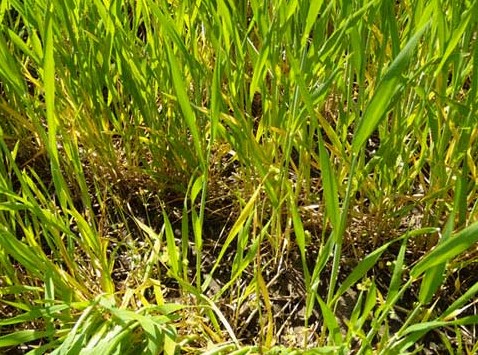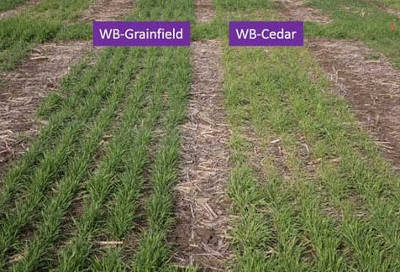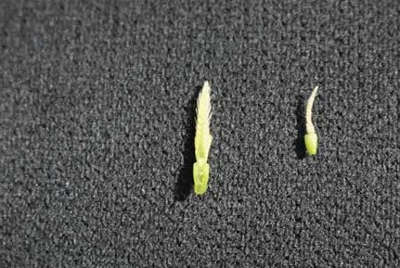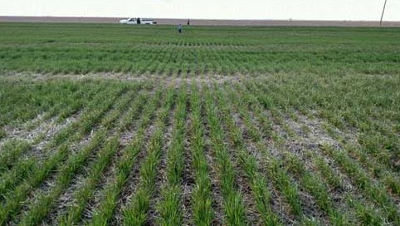By Romulo Lollato, Dorivar Ruiz Diaz & Erick DeWolf
There may be large areas, small patches, or streaks of yellowish wheat in some fields this spring. What are some of the main causes of yellow wheat in the spring?
Nitrogen deficiency. Nitrogen deficiency causes an overall yellowing of the plant, with the lower leaves yellowing and dying from the leaf tips inward (Figure 1). Nitrogen deficiency also results in reduced tillering, top growth, and root growth. The primary causes of nitrogen deficiency are insufficient fertilizer rates, application problems, applying the nitrogen too late, leaching from heavy rains, denitrification from saturated soils, and the presence of heavy amounts of crop residue, which immobilize nitrogen. This year, the excessive fall and winter soil moisture might have increased leaching in sandier soils and denitrification under water-logged soil conditions.

Figure 1. Nitrogen deficiency on wheat. The lower leaves are the first to become chlorotic (yellow). Photo by Dorivar Ruiz Diaz, K-State Research and Extension.
Sulfur deficiency. There has been an increasing number of fields with sulfur deficiency symptoms in recent years. Deficiency can be more common in areas where organic matter levels are low -- especially on sandier soils or eroded areas of a field. It can also occur where soils are cold in the spring due to a reduced rate of release of sulfur from organic matter. The symptoms of sulfur deficiency are very similar to nitrogen deficiency. However, sulfur deficiency differs from nitrogen deficiency in that the whole plant is pale, with a greater degree of chlorosis (yellowing of plant tissue) in the young leaves (Figure 2). The pattern of chlorosis may show gradation in intensity with the younger leaves at the tip yellowing first because sulfur is not easily translocated within the plant. But the entire plant can quickly become totally chlorotic and take on a light yellow color. Symptoms often become more pronounced when plants begin growing rapidly while soil conditions are such that organic matter mineralization and sulfur release rates are low. Symptoms may disappear as the temperature warms up and moisture conditions improve, which increases the rate of mineralization of sulfur from organic matter and the rate of root growth.

Figure 2. Sulfur deficiency in wheat, with symptoms appearing first on the younger leaves. Photo by Romulo Lollato, K-State Research and Extension.
Poor root growth. This may be due to dry soils, later sowing, waterlogging, or elevated crown height caused by shallow planting depth or excessive residue in the root zone (Figure 3). If the plants have a poor root system, then the plants are yellow because the root systems are not extensive enough to provide enough nutrients. This situation is characteristic of a large wheat area around Kansas this growing season, mostly led by a combination of late-sown fields (delayed due to early October rainfalls), cold fall and winter restricting crop growth, and waterlogging.

Figure 3. Left panel shows the lack of development of the crown rooting system of a wheat field due to drought conditions in the topsoil. Photo taken mid-March 2018 by Romulo Lollato, K-State Research and Extension. Right panel shows a slightly more developed but also extremely shallow rooting system, likely due to a restrictive dry topsoil layer. Photo taken by Tyler Ediger, wheat producer in Meade County, KS.
Cold weather injury at the tillering stage. A sudden drop in temperatures after the wheat has greened up but before it reaches the jointing stage will burn back the top-growth, often giving the field a yellowish cast but not reducing yield potential (Figure 4). The cold temperatures experienced April 11, 2019, might cause these symptoms in the next few weeks. This injury is likely cosmetic, provided the growing point is still healthy. Variety release from winter dormancy can also affect the extent of the symptoms, as early varieties would have been less cold hardy and thus likely sustain more injury.

Figure 4. Yellowing wheat from cold weather injury at the tillering stage. Wheat variety on the left (WB-Grainfield) has a later release from winter dormancy as compared to WB-Cedar (variety depicted in the right). Thus, WB-Cedar sustained more leaf injury. Photo by Romulo Lollato, K-State Research and Extension.
Freeze injury at the jointing stage. Jointing wheat can usually tolerate temperatures in the mid-to-upper 20’s with no significant injury. But, if temperatures fall into the low 20’s or below for several hours, the lower stems, leaves, or developing head can sustain injury (Figure 5). Temperatures dropped suddenly on April 11; thus, producers whose fields are already jointed should scout their fields to assess the yield potential. If the leaves of tillers are yellowish when they emerge from the whorl, this indicates those tillers have been damaged.

Figure 5. Comparison between a healthy developing wheat head (left hand side, typically light green and firm) versus a developing wheat head that sustained freeze injury (right hand side, whitish/brown and mushy). Photo by Romulo Lollato, K-State Research and Extension.
While the extent of potential freeze damage depends on minimum temperatures achieved, duration of cold temperatures, and stage of wheat development; other factors such as crop residue, position on the landscape, wind speed, snow cover, and soil temperatures also play a role. Figure 6 shows an example of the effect of heavy residue on potential wheat damage. In this photo, parts of the field with a heavier layer of residue show greater cold damage than lighter residue. This can be partially explained because under a thicker layer of residue, the wheat crown tends to form closer to the surface and therefore is more exposed to freezing temperatures.

Figure 6. Effect of soil residue on wheat freeze damage. Wheat is showing more damage from freezing temperatures in thicker residue layers. Photo by Tyler Ediger, wheat producer in Meade County, KS.
Iron chlorosis. Iron chlorosis is not common in wheat in Kansas, but does occur on certain high-pH, calcareous soils in western Kansas. Newly emerging leaves will have green veins, with yellow striping between the veins. Eventually, the entire leaf may turn yellow or white.
Soilborne mosaic or spindle streak mosaic. Soilborne mosaic and spindle streak mosaic are viral diseases that occur primarily in eastern and central Kansas, but are rare in western Kansas. These diseases are most common in years with a wet fall, followed by a cool, wet spring. The disease is often most severe in low areas of a field where soil conditions favor infection. Symptoms are usually most pronounced in early spring, then fade as temperatures warm. Leaves will have a mosaic of green spots on yellowish background. Infected plants are often stunted in growth.
Wheat streak mosaic complex. This viral disease is vectored by the wheat curl mite. Yellow areas in field will appear in spring around that jointing stages of growth; usually on field edges adjacent to volunteer wheat. Leaves will have a mosaic of yellow streaks, stripes, or mottling. Plants infected with wheat streak mosaic are often smaller than healthy plants.
Barley yellow dwarf. This viral disease is vectored by bird cherry oat aphids and greenbugs. Small or large patches of yellow plants will occur, typically around boot stage. Leaf tip turns yellow or purple, but midrib remains green. The yellowing caused by barley yellow dwarf are less botchy than the yellowing caused by other viral diseases. Plants infected by barley yellow dwarf are often stunted.
Source: ksu.edu